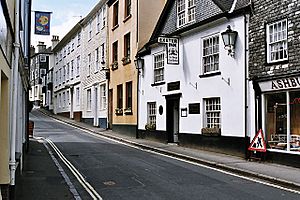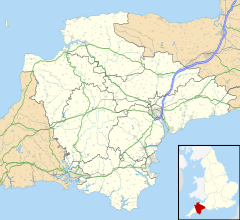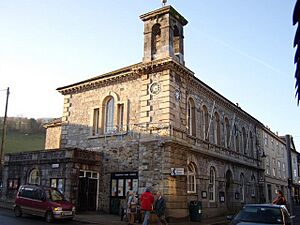Ashburton, Devon facts for kids
Quick facts for kids Ashburton |
|
|---|---|
 West Street, Ashburton |
|
| Population | 4,170 |
| OS grid reference | SX756698 |
| Civil parish |
|
| District |
|
| Shire county | |
| Region | |
| Country | England |
| Sovereign state | United Kingdom |
| Post town | NEWTON ABBOT |
| Postcode district | TQ13 |
| Dialling code | 01364 |
| Police | Devon and Cornwall |
| Fire | Devon and Somerset |
| Ambulance | South Western |
| EU Parliament | South West England |
| UK Parliament |
|
Ashburton is a town in Devon, England. It's located near the edge of Dartmoor, a beautiful national park. The town is about 20 miles (32 km) northeast of Plymouth and 17 miles (27 km) southwest of Exeter.
Long ago, Ashburton was a very important place for tin mining. It was called a 'stannary town' because it helped manage all the tin mining activities. Today, it's still the biggest town inside the Dartmoor National Park. The town is part of a larger area called Ashburton and Buckfastleigh, which had about 7,718 people living there in 2011.
Contents
Discover Ashburton's Past
What's in a Name?
The name Ashburton comes from old English words. It means 'farm' or 'settlement' with a stream. This stream was often visited by ash trees.
The town's name was first written down in the Domesday Book in 1086. Back then, it was called Essebretone. Ashburton was the main town of its area.
Ashburton During the English Civil War
During the English Civil War, Ashburton offered a safe place. Royalist soldiers found refuge here. They were running away after losing a battle. This battle was against General Fairfax at nearby Bovey Tracey.
Trains and Transport
Ashburton was once the end of a railway line. This line, called the Buckfastleigh, Totnes and South Devon Railway, opened in 1872. The Ashburton railway station stopped taking passengers in 1958. Goods trains continued until 1962. Today, you can still get to Buckfastleigh and Totnes by bus.
Ashburton Pop and Carnival Fun
Ashburton used to be known for a special drink. It was called Ashburton Pop. People thought it might have been like champagne. Sadly, the recipe was lost in 1765.
The Ashburton Carnival is very old. It might even be the oldest carnival in Devon. Records show it started in 1891. But people believe it began even earlier, in the mid-1880s. It was started to help raise money for a new hospital.
Sports and Learning in Ashburton
Ashmoor Hockey Club was created in 2003. They play their games at South Dartmoor Community College.
The Ashburton Cookery School & Chefs Academy is north of the town. It started in 1992. It is known as one of the best cooking schools in the country.
Explore Ashburton's Landmarks
St Andrew's Church
The parish church of St Andrew is a very old building. It was built in the 15th century. It has a tall tower and two aisles. The church tower has sculptures by Herbert Edmund Read. He also carved the oak reredos, which is a screen behind the altar. One window has beautiful stained glass. This glass was designed by C. E. Kempe. Part of the church's porch is even older, built in the Norman style.
St Lawrence Chapel
St Lawrence Chapel is another historic building. It is located in St Lawrence Lane. This chapel was first a chantry chapel. This means it was used for prayers for the dead. Then, for over 600 years, it was a grammar school. Now, St Lawrence Chapel is a community center. It is managed by the Guild of St Lawrence.
Ashburton Arts Centre
The town's old Methodist Church was built in 1835. In 2015, the Methodist church group moved. Their old building was sold in 2017. It was bought by Ashburton Arts Ltd. This is a group that helps the community. The building is now the Ashburton Arts Centre.
St Gudula's Well and Cross
St Gudula's Well and Cross is on Old Totnes Road. It is probably named after St Gulval. This saint is also honored in a village in Cornwall.
Ashburton Town Hall
The Ashburton Town Hall was first built in 1850. It was originally a market hall.
Ashburton's Weather
| Climate data for Ashburton, 1981–2010 normals | |||||||||||||
|---|---|---|---|---|---|---|---|---|---|---|---|---|---|
| Month | Jan | Feb | Mar | Apr | May | Jun | Jul | Aug | Sep | Oct | Nov | Dec | Year |
| Mean daily maximum °C (°F) | 9 (48) |
9 (48) |
11 (52) |
13 (55) |
16 (61) |
19 (66) |
21 (70) |
21 (70) |
18 (64) |
15 (59) |
12 (54) |
10 (50) |
15 (58) |
| Mean daily minimum °C (°F) | 4 (39) |
4 (39) |
5 (41) |
6 (43) |
8 (46) |
11 (52) |
13 (55) |
13 (55) |
11 (52) |
9 (48) |
6 (43) |
5 (41) |
8 (46) |
| Average precipitation mm (inches) | 126.4 (4.98) |
96.2 (3.79) |
93.0 (3.66) |
73.5 (2.89) |
75.7 (2.98) |
65.0 (2.56) |
68.0 (2.68) |
72.2 (2.84) |
80.7 (3.18) |
123.0 (4.84) |
121.4 (4.78) |
139.7 (5.50) |
1,134.8 (44.68) |
| Source: Chelsa Climate | |||||||||||||
Famous People from Ashburton
Many interesting people have connections to Ashburton. Here are a few:
- William Howard Allen (1790–1822) was a United States naval officer.
- Alexander Baring, 1st Baron Ashburton (1774–1848) was a politician and financier.
- William Bickford (1774–1834) invented the safety fuse. This was used in mining.
- Richard Carlile (1790–1843) was a political activist.
- John Dunning, 1st Baron Ashburton (1731–1783) was a lawyer and politician. He was born in Ashburton.
- William Gifford (1756–1826) was a critic, editor, and poet.
- John Ireland (Anglican priest) (1761–1842) was born in Ashburton. He also taught at the grammar school.
- Charles Eamer Kempe (1837–1907) designed the stained glass windows in St. Andrew's Church.
- Sir Robert Palk, 1st Baronet (1717–1798) was born in Ashburton. He was also a Member of Parliament for Ashburton.
- Stevie Smith (1902–1971) was a poet and novelist.
- Thomas Glanville Taylor (1804–1848) was an astronomer. He was born and educated in Ashburton.
- Ollie Watkins (born 1995) is a professional footballer. He was educated at South Dartmoor Community College.
- William John Wills (1834–1861) was an explorer. He went to St Andrew's Grammar School in Ashburton.
See Also
 In Spanish: Ashburton para niños
In Spanish: Ashburton para niños



